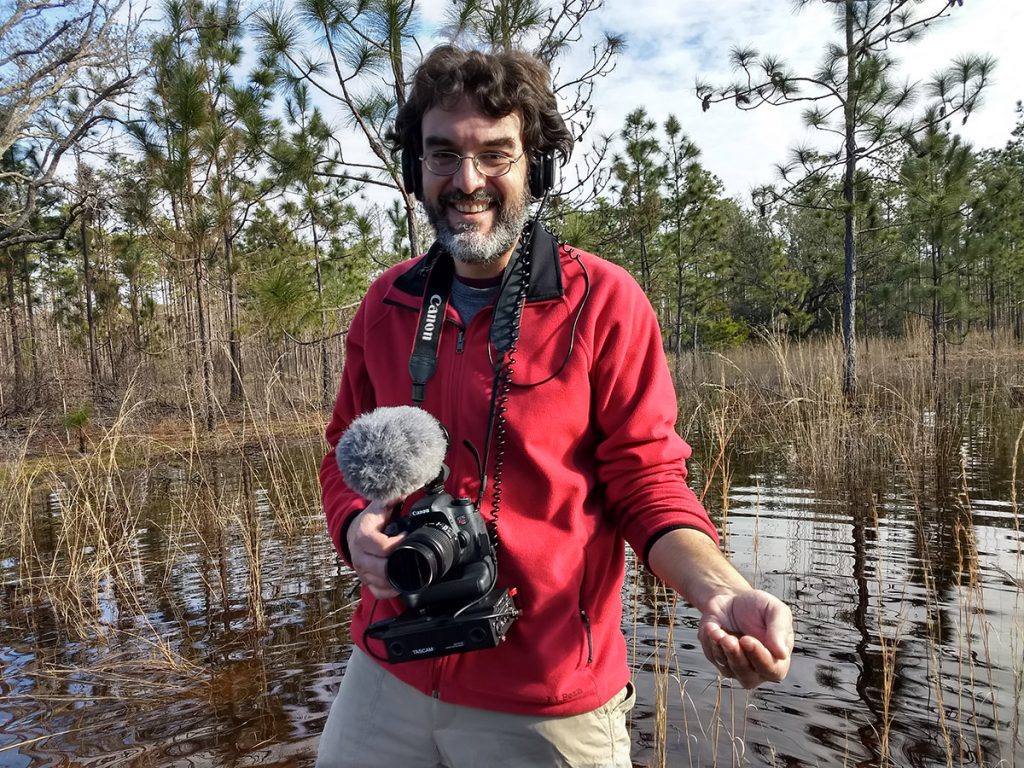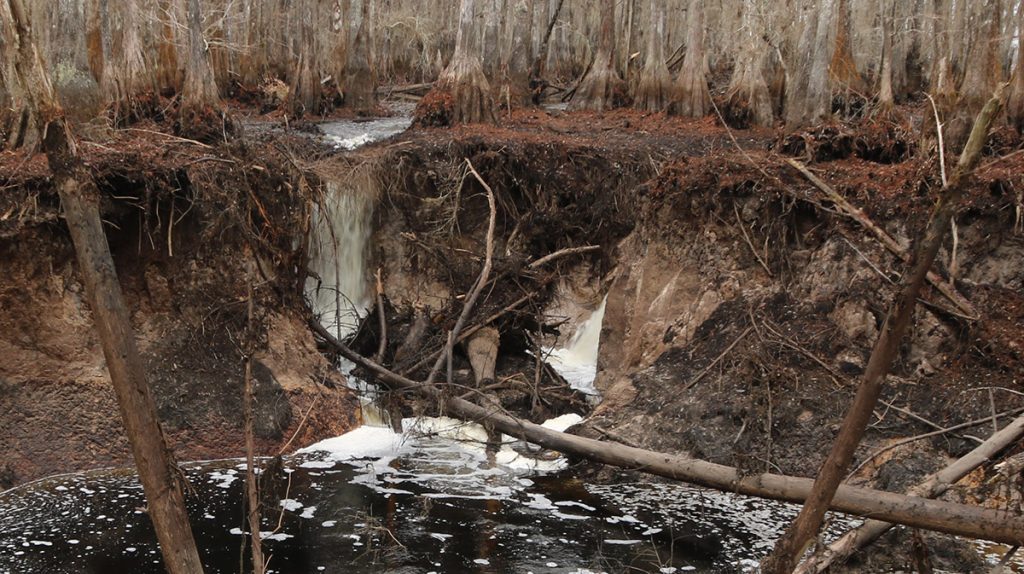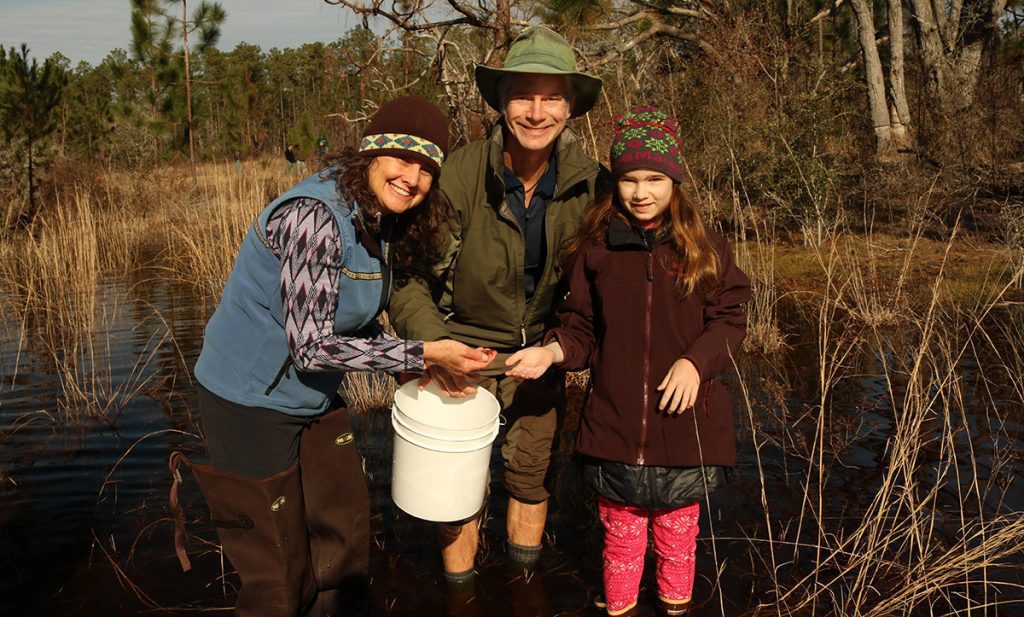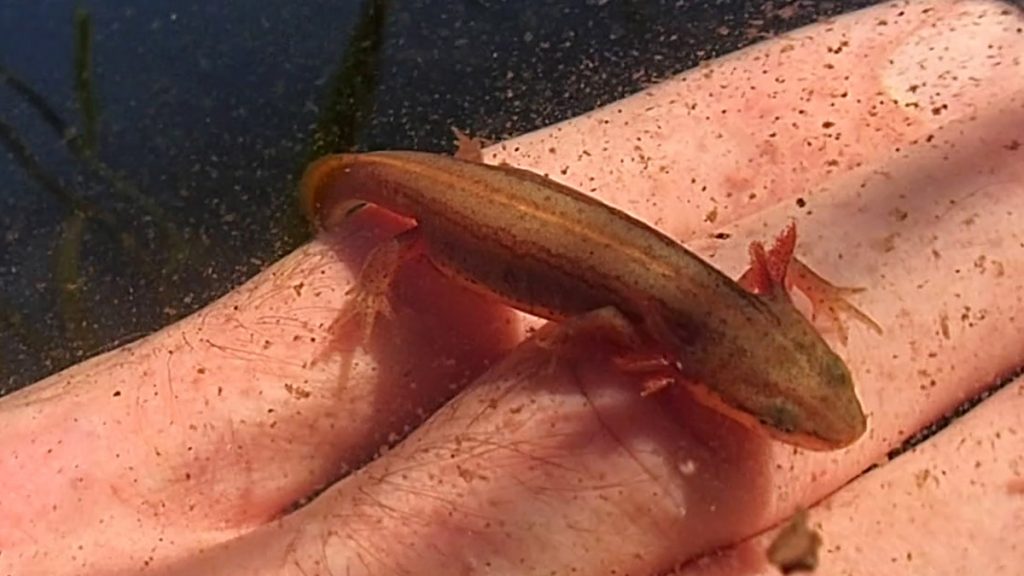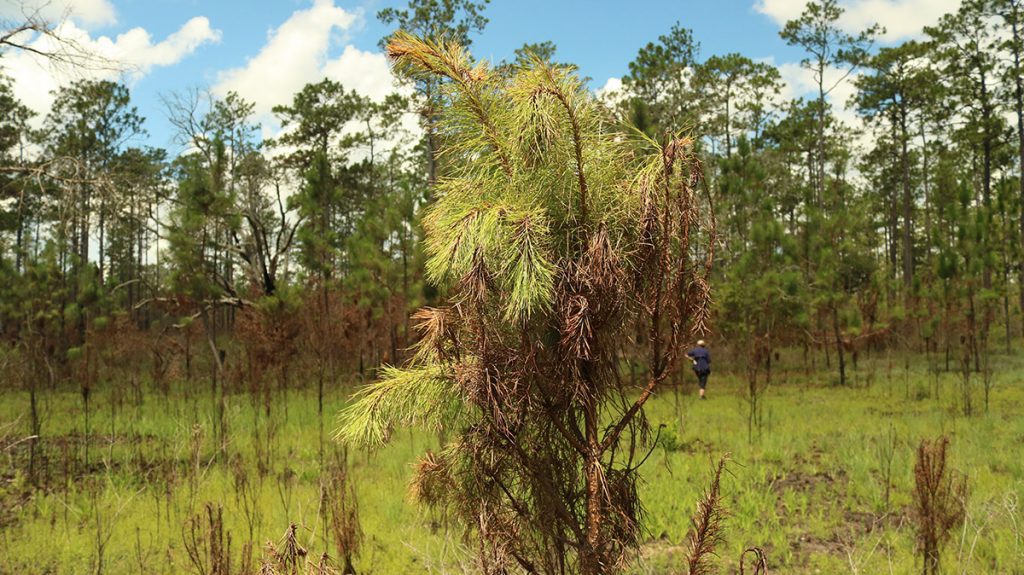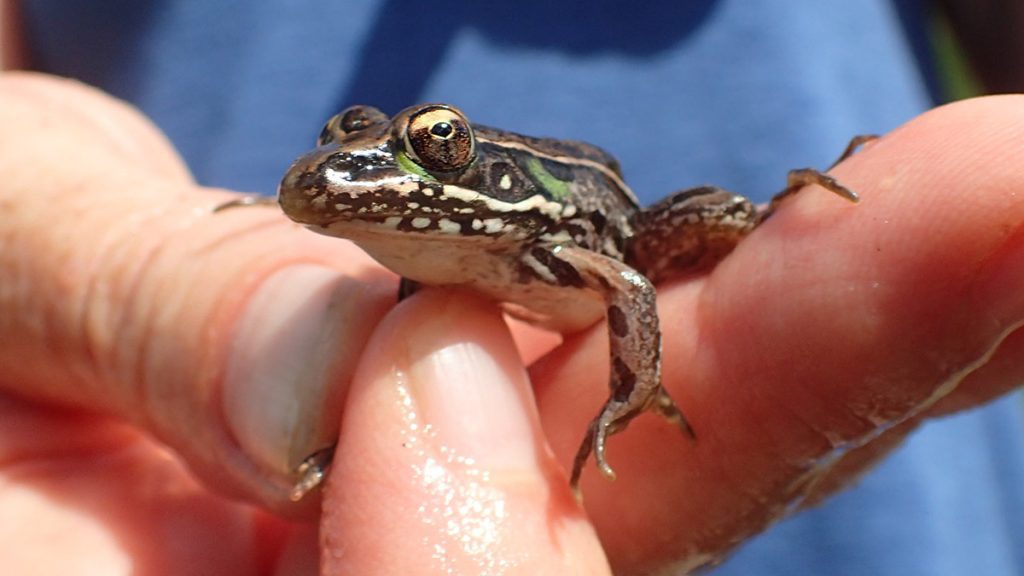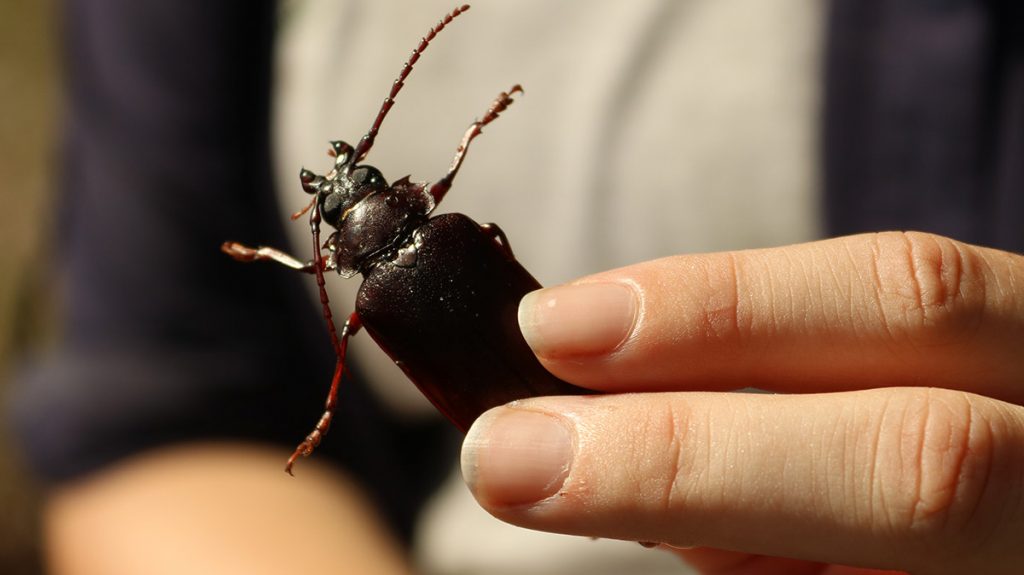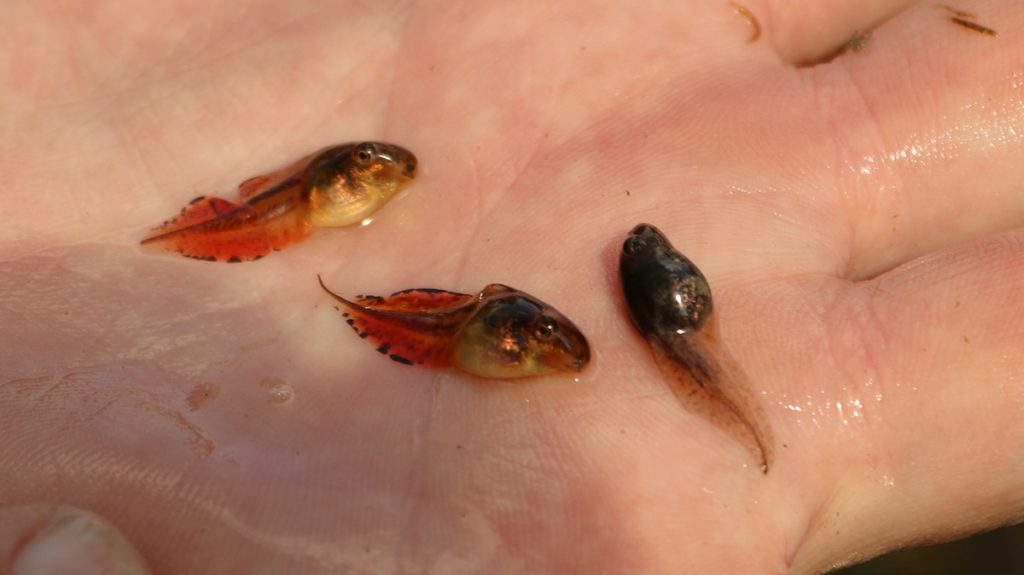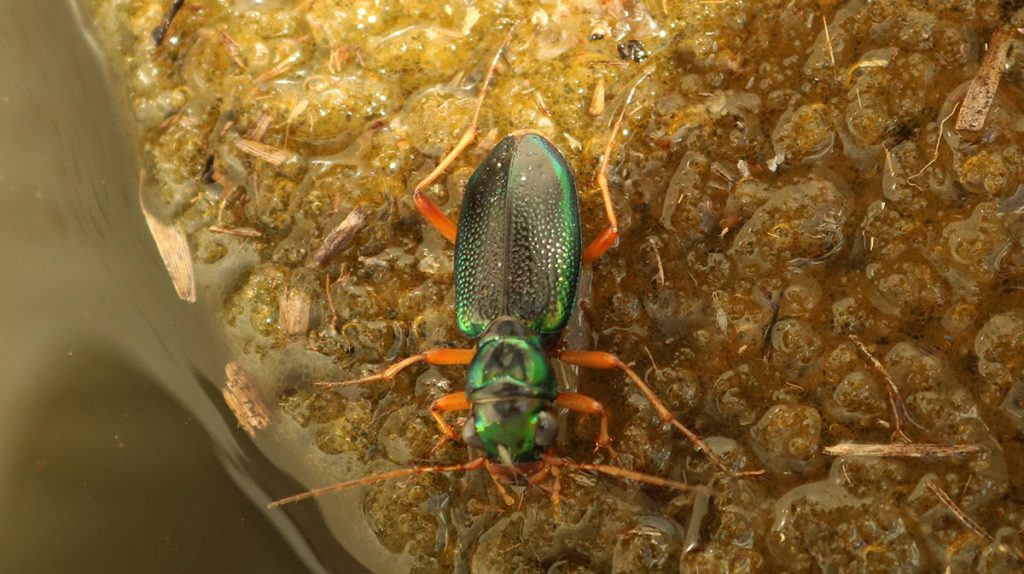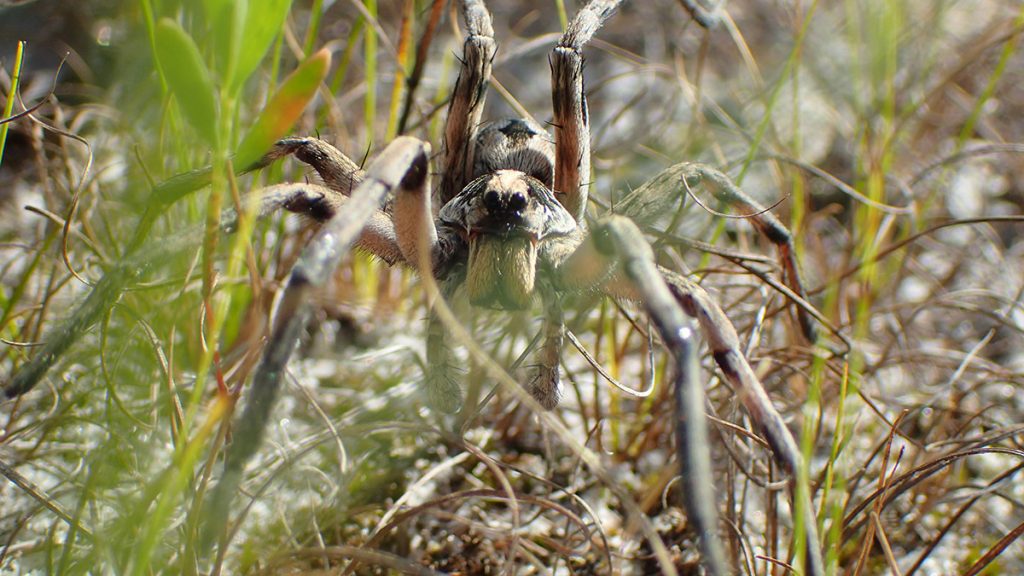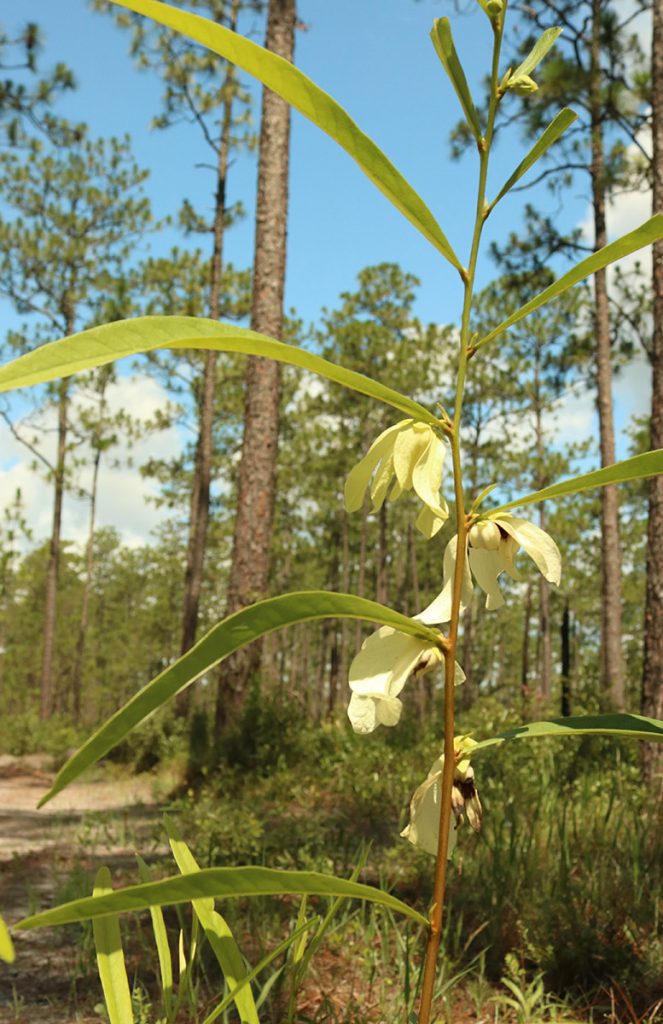We visit one of our main EcoCitizen Day locations: the Munson Sandhills of the Apalachicola National Forest. Here, ephemeral wetlands are filled with fire dependent amphibians, such as the imperiled striped newt (Notophthalmus perstriatus)…
Subscribe to the WFSU Ecology Blog to receive more videos and articles about our local, natural areas, and subscribe to the WFSU Ecology Youtube Channel.
In a fun bit of role reversal, I find myself holding two striped newts while Rebecca Means points a camera at me. The chilly January water is over the tops of my boots, soaking my socks. After a year in which ephemeral wetlands in the Apalachicola National Forest were on the dry side, the newts and other amphibians that breed here finally have conditions favorable for reproduction. The wetlands are flooded.
It’s a good two year period to use to understand how these wetlands work. In 2017, rainfall was low enough to drop the level of the Floridan Aquifer in Leon County. The aquifer is the source of our drinking water, and it feeds a host of waterways in our area. This includes springs and rivers, like the Wakulla and Wacissa. It’s also directly connected to several lakes, through sinkholes. In fact, early last year, as ephemeral wetlands were going dry, two of Lake Miccosukee’s sinkholes became active and drained a portion of the lake.
It can be alarming to see lakes and wetlands dry out. However, they’ve gone through this cycle for thousands of years. And animals like striped newts have evolved to exist in this specialized type of environment. Unfortunately, our changing climate has affected these normal cycles. In the 1990s, an extended drought came close to ending the striped newt’s time in the Apalachicola National Forest.
That’s why we’re here today.
The Striped Newt Repatriation Program
In January of 2016, I received a last minute invitation to film my first striped newt release. I had never heard of the animal, and wasn’t familiar with the Munson Sandhills region of the forest, where they had historically lived. But I was intrigued by its story. It’s a salamander that lives in a type of disappearing pond that, a few years ago, disappeared for too long. You can look at the climate data I pulled together for that 2016 post. Twenty four of the previous thirty two years were drought years. The wetlands’ natural cycle had been disrupted, and striped newts almost entirely vanished from the region.
A lot of organizations have come together to make sure this small critter fills its niche in the forest. The Jacksonville and Detroit Zoos, and the Orianne Center for Indigo Conservation, have bred thousands of newts over the years, starting with a handful picked from Georgia wetlands. This year, they were able to increase the genetic diversity in their wetlands by including one of the few remaining newts from the original Apalachicola National Forest population.
The US Forest Service, Florida DEP, Florida Fish and Wildlife, and Tall Timbers Research Station and Land Conservancy are also partners. But the organization spearheading this is the smallest.
Ryan and Rebecca Means are the Coastal Plains Institute. They’ll be monitoring the wetlands over the next few months. However, their main tool in doing so has been rendered useless by the fullness of the pond.
Winter Breeding Amphibians
It’s a simple system, really. A fence encircles the pond, with buckets spaced along it on both sides. After mating, newts try to leave and hit the fence, wandering until they fall in a bucket. Rebecca, Ryan, and their volunteers check the buckets daily to see what was leaving, and what was coming back. After recording the information, they place them where they were trying to go.
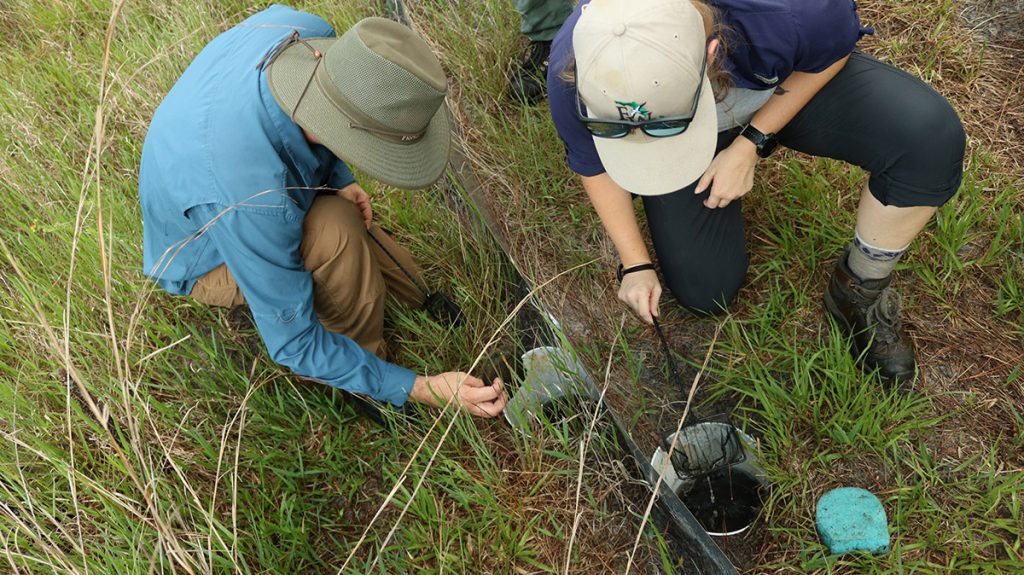
Here you can see the drift fences in action after the June 2018 release. To the left is the inside of the fence, and the ephemeral wetland.
In this way, they can see how many newts are surviving, and about how many are returning to breed. They can also see what other animals are in the wetlands. In most years, it’s a great tool.
This year, though, the fence sits under a foot of water. It’s a problem, and it isn’t. “Now we can’t check our drift fence,” Ryan says. “But we have lots and lots of water to release our newt crop into.”
Last year at this time, the drift fence was easy to check. But the wetlands didn’t receive enough rain to have a release until June. Striped newts are winter breeders, and so when CPI releases them every January, they release gravid, egg bearing females with the males. They release them two at a time. Sometimes, the male and female clasp onto each other before we lower them into the water. Other times, they swim off in different directions.
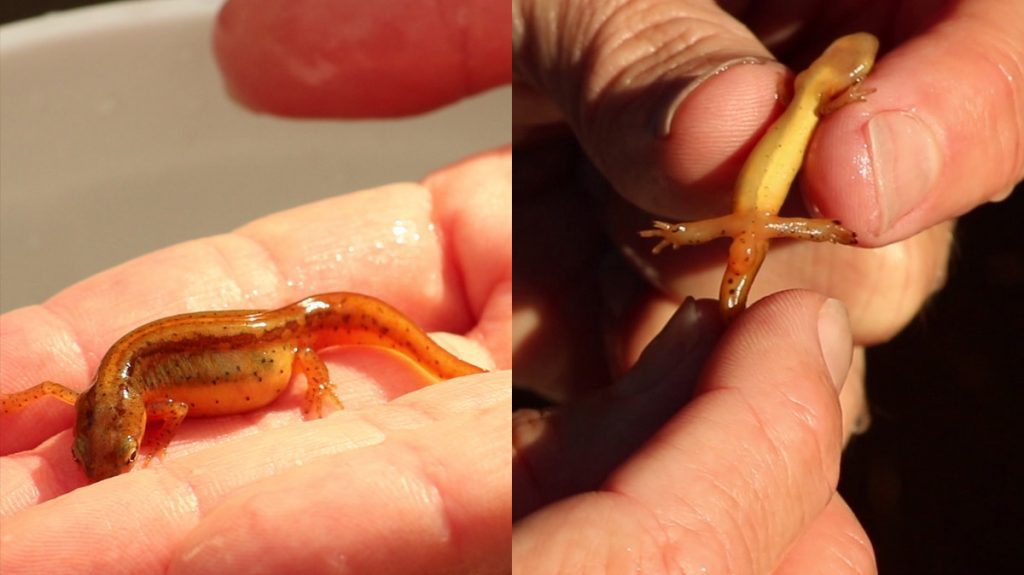
On the left, you can see a female striped newt, full of eggs. The male, right, is smaller. His black tipped claws and larger hind legs help him clasp to the female while mating.
For their June 2018 release, it wasn’t seasonally appropriate to release breeding adults. So they released larvae.
“The larvae we released were older larvae,” Rebecca says. “They were larvae that were larger in size, and therefore able to metamorphose pretty quickly.”
You can see it in the last shot of the video; what looks like a full sized newt, but sporting a large set of external gills. Without an assurance that their wetlands would get any wetter, Rebecca and Ryan hoped that the newts would soon lose their gills and change into their terrestrial form. From there, they’d head into the surrounding pine forest.
Fire in Ephemeral Wetlands…
As it happened, we did have a wet fall and winter. Eventually, the aquifer beneath was filled, and then the ponds. And then they were over-filled. And so ended an inconvenient 2018 for the Striped Newt Repatriation Project. But, while the ponds were dry, it wasn’t all bad.
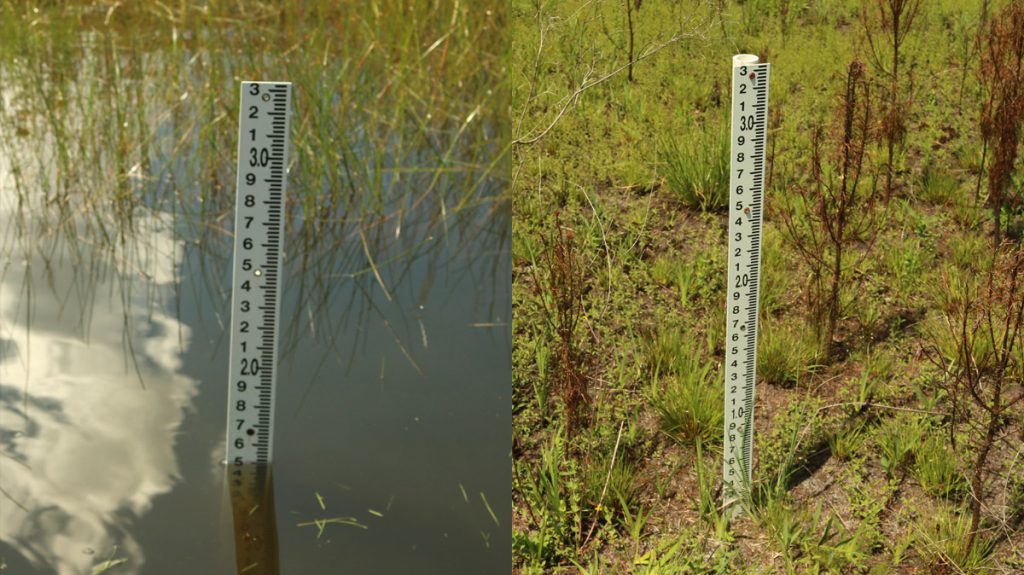
As you can see from CPI’s rain gauges, the striped newt release wetland had a few inches of water in June of 2018. The adjacent, unlined wetland on the right, was dry.
After their June 2018 release, we walked over to one of their reference ponds. Their release ponds are lined to hold water, and each one has a sister wetland nearby that shows more or less how wet or dry their wetland would be without the lining. As we see in the video, it was bone dry, and a little charred from a recent wild fire.
The surrounding forest is a longleaf pine ecosystem. I feel like I write this a lot, even when I’m not setting out to write about longleaf forests (like my milkweed piece from a couple of weeks ago). But the flowers, grasses, and forbs in this ecosystem thrive with regular fire, needing it to kill off any woody plants that might crowd them out. These non-woody plants are full of food and shelter for a large diversity of animals. When fire burns through every couple of years, this is a thriving habitat.
The same is true of the ephemeral wetlands within the forest, which go dry when the forest is dry, and hot. “It’s during that May, June, and July period,” Ryan says, “when we have summer thunderstorms, with frequent lightning, on top of a spring and early summer dry period- oh man! You get a lightning strike … and you could have ignited a landscape fire.”
Much like in the upland forest, fire keeps oaks and woody shrubs out of the ponds. “Without fire,” Ryan says, pointing to the wetland behind him, “This wetland would succeed to a shrub, or forested swamp. It would not be a marshy, open wetland, full of a vast diversity of succulent vegetation.”
…Flood in Ephemeral Wetlands
“There’s another factor that helps to perpetuate this kind of wetland, and that’s flood. ” Ryan explains, “It needs to have plenty of water in it every once in a while to exclude any upland plants that would love nothing more than to come into this wide open free for all with plenty of sunlight, and colonize it.”
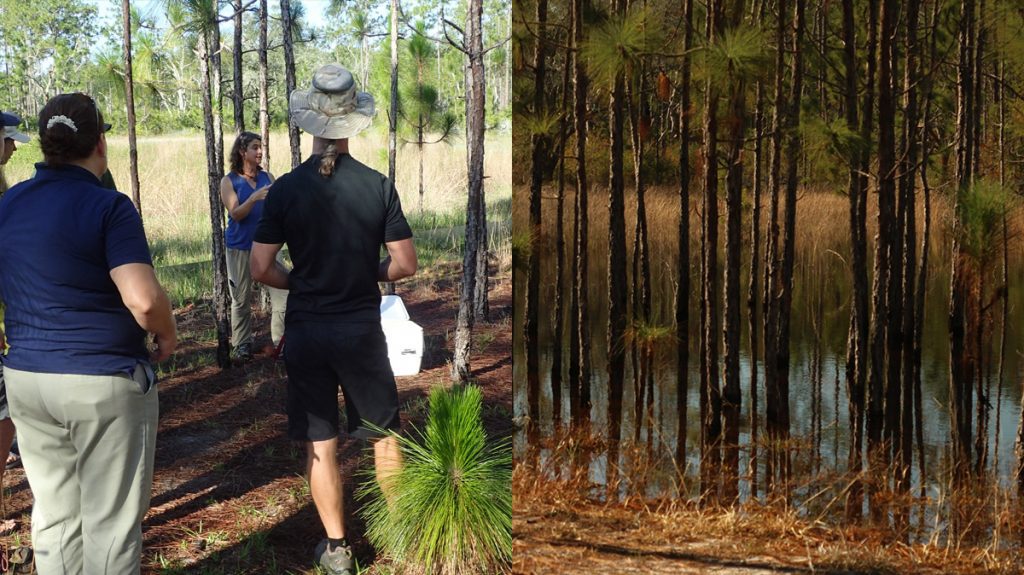
Left, you can see Rebecca talking to project partners in a stand of longleaf pine that grew at a wetland’s edge during an extended drought. At right, in January of 2019, these same trees are standing in water.
He’s previously pointed out the row of pines growing close alongside one of their release ponds. These encroached on the banks of the wetland during the drought that nearly did the newts in. Today, these dry, upland trees are standing in water (the red cockaded woodpecker we see in the video was pecking around on those). More importantly, some much younger pines were barely holding their crown of needles above the water. The more established plants, which Ryan estimates are about 20 years old, will survive this flooding. The smaller ones will likely not.
You can see why striped newts, and other amphibians in these wetlands, have seen a decline.
The wetlands have to burn when they’re dry, or hardwood trees will grow in them, and eventually shade out the grasses and succulent plant these critters need. But the wetlands can’t stay dry for too long, or plants more suitable to a dry environment would take over.
Unfortunately, fire is often excluded from these habitats, or had been excluded for long enough for there to be long term effects. And longer, more intense droughts have become more common in the last few decades. The delicate balance needed to keep these ponds viable is getting harder to achieve.
What had been a species that ranged from Orlando to south Georgia is now limited to about 100 ponds in the far north of Florida and the far south of Georgia. And the Apalachicola National Forest population is barely hanging on, needing a regular influx of human released newts to sustain itself.
Ephemeral Wetlands and the EcoCitizen Project
The Coastal Plains Institute, along with the Florida Fish and Wildlife Conservation Commission, are WFSU’s primary partners in the EcoCitizen project. Our shared goal is to find ways to engage people with the outdoors, and with science, in a way that they’d find enjoyable. We want people to learn about nature while helping it, either by enhancing pollinator habitat at home or by adding to scientific knowledge about nature (sometimes without leaving that pollinator garden).
You can read more about the specifics in a post I wrote last month.
The reason I reached out to CPI to partner with us on this project, which is funded by WNET’s Nature program and the National Science Foundation, is their use of citizen scientists to further their research goals. When their striped newt drift fences are checkable, they rely on trained volunteers to check them and report their finds.
Those newts are one of many amphibians found in the ephemeral wetlands of the Munson Sandhills. That’s why CPI recruits families to help monitor several dozen wetlands in the region. I’ve written about the Adopt an Ephemeral Wetland program before; my family and a couple of others have been participating for a couple of years. This is Citizen Science- people not trained in science helping the professionals collect data. If you’re interested in getting wet and mucky and helping them survey wetlands for tadpoles, newts, and whatever else is in there, check out their program page.
Or, perhaps you don’t want to commit to adopting a wetland and sampling it a couple of times a year. Why not come down to the Munson Sandhills on EcoCitizen Day, on April 27 from 9-2 pm? EcoCitizen Day is a part of the Leon County City Nature Challenge, where our county is competing with 170 other locations around the world to record as many species as possible using iNaturalist.
But we’re celebrating all Citizen Science. So you can make observations in the forest- birds, butterflies, flowers- and dipnet a wetland to see what amphibians you find (and also record on iNaturalist). We have limited space for these forest trips, and we’ll have info out soon about signing up to go.
The Critters We Saw in the Video (Identified with the help of iNaturalist)
Often when we have videos with a lot of animals, we highlight a few but don’t always identify every species. After all, in a video with a few dozen butterfly species, singling them all out would bog the video down. But that’s why we have the blog. This video above had a lot of different types of animal- snakes, frogs, newts, beetles, and spiders. That’s a lot to identify. So I thought, since iNaturalist is going to be such a big part of what we’re doing in the coming months, why not upload some photos from the day and see what this app had to tell us?
00:00 Striped newts (Notophthalmus perstriatus) being released on January 31, 2019. These are breeding adults.
01:49 Here is our first closeup look at the newts released on June 27, 2018. It has the form of an adult, but still has large external gills. This is an older larva. The next few identifications are from this June release.
01:54 Banded water snake (Nerodia fasciata). Ryan sees this and leaps at it. He doesn’t just do this because it’s fun video (though we’re thankful he did)- this is an animal that might eat striped newts. In fact, he feels something in its stomach. You hear Ryan’s father, Dr. Bruce Means, suggest that maybe you can squeeze the stomach contents out and see…
02:04 Here Rebecca holds a southern leopard frog (Lithobates sphenocephalus). I had forgotten what frog this was, though Rebecca identified it at the time. Rather than go through the raw footage, I uploaded it to iNaturalist. At first, I identified it as a True Frog, family Ranidae. Another user suggested southern leopard frog, and looking at that species (each one has a profile page on iNaturalist where you can check photos), I agreed. With two identifications, iNaturalist considers it Research Grade.
02:07 Right now (February 27), my iNaturalist observation for this says Tribe Prionini, which includes the genus I had originally thought it was- Prionus– and the identification made by another user – Brown prionid beetle (Orthosoma brunneum). That user left a comment- “Pronotal apices differentiate from similar Derobrachus genus.” I had to Google both pronotal and apices. Pronotal refers to the prothorax, the uppermost section with legs. Apices is just a plural form of apex. I feel this other user’s identification is right, but I want to check a little more before making it research grade. I want to understand the ID before making it. Edit 3/6/19– After an exchange between different users, the consensus now is that this was in the Prionus genus– Prionus pocularis, the tooth-necked longhorn.
02:08 Ornate chorus frog tadpoles (Pseudacris ornata) or southern chorus frog (Pseudacris nigrita). I haven’t tested iNaturalist with amphibian larvae yet. For this, I’m using the laminated guides Rebecca gave us for the Adopt an Ephemeral Wetland program. In both species, the tail fin starts right behind the eyes. Would you consider that a coppery belly? That would indicate a southern chorus frog. I’ll revisit this one.
02:10 Virginia metallic tiger beetle (Tetracha virginica). iNaturalist suggested both the Carolina and Virginia metallic tiger beetle. The coloration is similar, but I felt like was closer to Virginia, as was the body shape. Another user agreed and this observation is research grade.
02:11 Wolf Spider, likely Carolina wolf spider (Hogna carolinensis). At first, I entered it as wolf spider and allies-Superfamily Lycosoidea. Another user narrowed it down to wolf spiders, Family Lycosidae, and then finally, another user went with Carolina wolf spider, Hogna carolinensis. I’ll take a closer look soon.
02:18 The thing I’d point out here is how close to the surface the grass is. There was enough water and grass for the newts to seek shelter for predators in June, but in January they disappeared from sight much more quickly, and into a much fuller pond.
02:36 Longleaf pine (Pinus palustrus) sapling. These younger trees had established themselves in the reference wetland near the CPI release pond, and were burned in a wildfire. As longleaf start to develop branches, their barks thicken and they’re less likely to die in a fire. Have these matured enough survive being burned as thoroughly as they look to have been? The combination of fire, and the wetland’s current flooded state, doesn’t bode well for these young pines trying to get established.
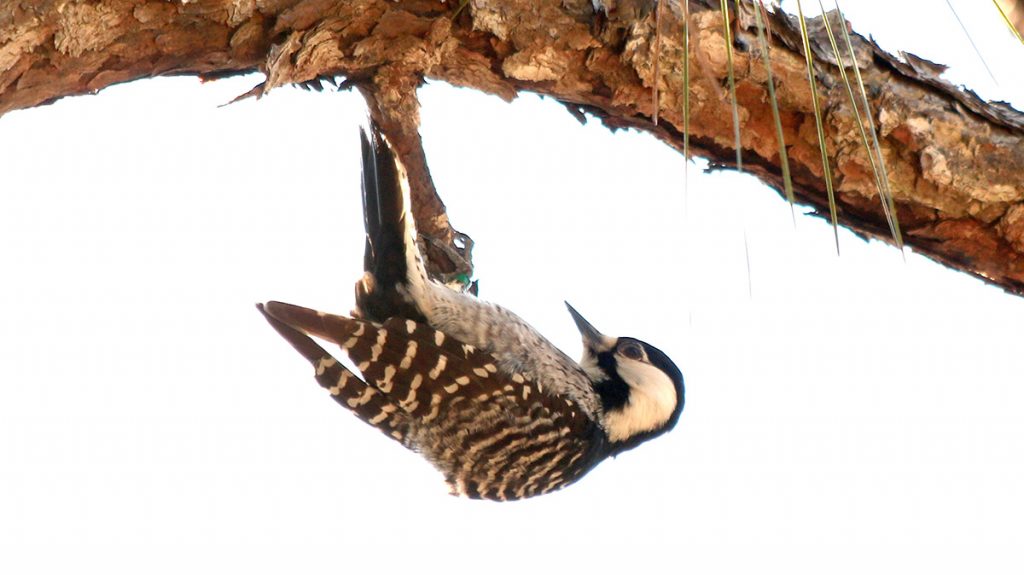
Because of their relationship with longleaf pine, red cockaded woodpeckers are associated with the ecology of fire. But the amphibians found in an ephemeral wetland are just as dependent on fire.
03:04 Red cockaded woodpecker (Dryobates borealis). This little woodpecker flew up as the January newt release was ending. It pecked away at the longleaf pine standing in the water at the Pond’s edge, which Ryan estimated to be about twenty years old (dating back to the 1990s drought). I ID’d this with my Sibley’s guide before uploading to iNaturalist, and finally know how to distinguish them from a downy or hairy woodpecker: The RCW has an all white cheek. Looking at the photos when I returned to the station, I also noticed a green leg band.
Bonus:
Here’s a fun case. It’s a wildflower identified by Ryan as Lake Jackson pawpaw (Asimina spatulata). It’s in my wildflower guide, but, it’s not in iNaturalist. I selected an ID of pawpaws- Asiminia genus– with a note that I thought this was Lake Jackson pawpaw. iNaturalist has a type of user called a curator- they’re biologists, different specialists in birds, butterflies, wildflowers, etc. One of them identified it as Asimina longifolia subspecies spatulata, with a note that he would create an entry for Lake Jackson pawpaw as a species, and not a subspecies of a flower found east of the Suwannee.
And so you can see the power of the user community in iNaturalist. You make the best guess you can, and experts might provide insight into whether you were right or wrong. And in some cases, they can improve the app. We’ll have more iNaturalist enhanced adventures in the coming weeks.

